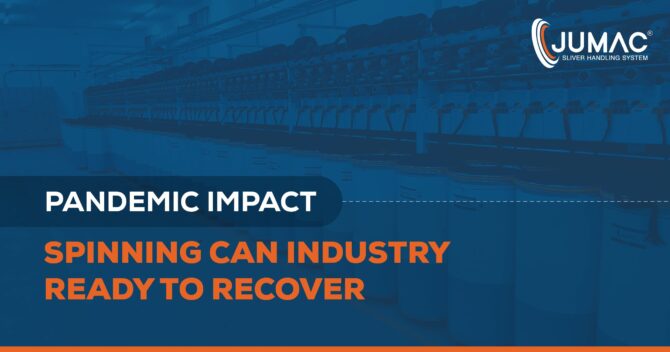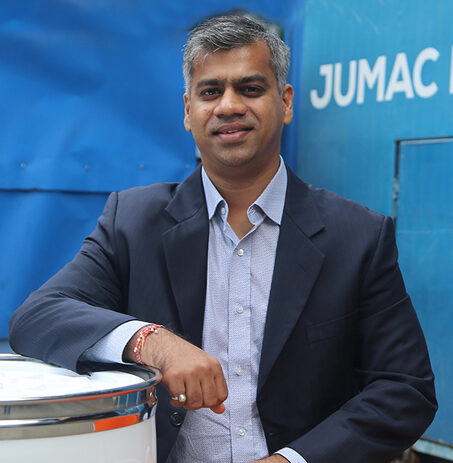Technology is changing the face of modern-day manufacturing facilities. The…

Pandemic Impact: Spinning Can Industry Ready to Recover
The world might be showing early signs of recovery from the COVID-19 pandemic – but the widespread damages it has caused for practically all business sectors is (and will continue to be) apparent to everyone. In India, every major industry has suffered in a big way – and the textile and spinning cans industry has hardly been an exception. Sales have slumped, trading activities (exports) have gone down, there have been huge losses in employment, and scenes of spindles and yarns remaining idle have become disturbingly commonplace.
Of late though, there have been unmistakable signs that the Indian textile is on the way to recovery from the ravages of the pandemic. We explain more here:
Fibre Exports & Sales Are Recovering Steadily
The total value of textile and apparel (T&A) exports dipped by an alarming 29% between the first half of 2020 to that of 2021. While apparel exports fell by nearly 40%, exports of filaments nosedived by a whopping 49%. However, reports from the second quarter of this year are offering fresh hope for textile makers and leading manufacturers of sliver cans. The most encouraging news has been in the form of fibre exports, which has risen by ~80% on a YoY basis. This jump has mainly been driven by significant increases in cotton exports, coupled with the ban on Chinese cotton products placed by the United States. Consolidated sales of textile products have nearly doubled (97% rise) between 2020 Q1 and 2021 Q1. The average EBITDA (earnings before interest, taxes, depreciation, and amortization) figure for the corresponding period has also risen by 7.5%. While total fibre exports dropped by a huge 56% in the first quarter in 2021, the fall has been only 1% in the next quarter. Things are stabilising, slowly but surely.
Gradual Increase In Strategic Investments
With the help of selective, targeted investments, the T&A sector can generate considerable economic advantages – necessary for the industry to turn the corner. Raw materials that place excessive strain on non-renewable resources are gradually being replaced by high-quality recycled materials. This, in turn, is boosting the overall sustainability factor. Recycled fibres also present a highly viable investment opportunity. By using cutting-edge tools like robotic sewing, laser-cutting equipment and even advanced nanotechnology applications, yarn-makers and spinning can manufacturers are bringing down lead times and making production cycles optimal. Technical transformation – through things like 3D printing and AI/ML applications – is also set to be the ‘new normal’ in the post-Covid textile industry operations. The trend of having factories physically close to their final sales markets is also gaining momentum. Manufacturers are striking up strategic partnerships with first-tier exporters and suppliers. In addition, the need for having supply chains with end-to-end traceability and transparency has become more important than ever. In this context, the role of blockchain technology applications is also growing in the fibre/yarn-making sector.
Tactical Strategies and Smart Collaborations
Leading textile manufacturers are putting in extra effort to enhance their processing capacities and eliminate infrastructure gaps. The focus is squarely on making T&A production more sustainable than before. For the top sliver can makers, like Jumac Cans, the emphasis on maintaining quality excellence has received fresh impetus. A wide range of new business collaborations – between textile suppliers, weaving mills, spinning can makers and other stakeholders – are opening up scopes of vertical integration in the industry. These strategic partnerships are likely to pave the way for greater value additions and will maximise ROI levels. Favourable co-financing arrangements are also being made, to ease the textile industry back to its high levels of production.
Steadily Rising Demand In The Global Textiles and Spinning Cans Industry
The Investment Information and Credit Rating Agency (ICRA) has predicted ‘greater stability’ in the textile sector in 2022. The initial recovery trends that started in 2021 Q2 will continue to grow stronger – with worldwide demand levels continuing to go up. This recovery is being fueled by the gradually reopening economies and markets, spurt in discretionary spending levels, and better investor sentiment/buyer confidence. It can be reasonably expected that the worst effects of the pandemic on the textile sector are behind us. Regular activities all across the textile value chain are being resumed systematically. Revenues from cotton yarn spinning and apparel exports are set to grow at >20% next year (after a sharp dip in early-2021). Greater demand will translate to a more competitive textile trading environment, and returns will be higher.
Expansion In The Scale Of Textile Production
As expected, the different sub-sectors within the textile industry are recovering at different rates. Products that are relatively low-end, including essential products, are delivering maximum value for money – and such products are moving at the best rates. Fashionable textile products, on the other hand, are recovering more slowly. The average export orders for the next couple of quarters are encouraging – providing further evidence of the stabilisation of the sector. The onus is on yarn manufacturers and spinning can suppliers to scale up production only after analysing demand levels carefully, to avoid losses and maximise returns. MSME financial packages from the Indian government have also helped in improving the liquidity factor. The authorities have also ensured that target beneficiaries do not face any problems while trying to access the benefits of such packages. It has to be understood that the effect of the pandemic has been devastating. Recovery will be gradual, and patience will be of the utmost importance.
Minimal Loss Of Manpower
Apart from production downturns, the coronavirus pandemic caused most textile companies to lose valuable manpower as well. Following the initial breakout of the pandemic, a large percentage of unorganised labour had to return to their respective hometowns. The arrival of the pandemic’s second wave had also stunted the initial recovery trends. With things finally looking up and export orders increasing, MSMEs are ensuring that they do not face the same labour-related problems all over again. Employees are being taken care of in a better way, with minimal or no salary deductions, layoffs are being avoided as much as possible, and companies have not lost out on talented manpower resources. The month-on-month cotton prices have been rising since the start of this year, which is also a telltale sign of the rising demand levels.
Rise Of The Online Textile Industry
With lockdowns in place and pandemic threats still lingering, the traditional way of doing business in the textile industry has taken a huge hit. It is the online textile sector that has remained strong in the face of adversity, and has been the face of business recovery in this sector. Makers of technical textiles and sliver cans are also ensuring that buyers can get in touch with them online, quickly and easily. Since the online retailing industry is, by definition, contactless – the pandemic has not affected it as much (although the average purchasing power of customers has gone down). This trend is very likely to continue, with online textile retailing growing in value in the foreseeable future. Having no middlemen is a big advantage, as are the lower costs and buyer-friendly policies. While the textile industry as a whole gradually gets back to its feet, the online sector is likely to emerge as the gamechanger.
The global pandemic has propped up unprecedented challenges for the textile and spinning can industry in India. However, the sector is on its way to recovery – and helpful governmental policies like ‘Make in India’ and the recently-announced ‘Production Linked Incentive (PLI)’ scheme are offering the much-required support. It will be a hard, long grind for the sector to get back to pre-Covid levels, but the first steps have already started in the right direction.
Jumac Manufacturing, the largest spinning can exporter brings you industry-wide insights. To keep yourself acquainted, consider subscribing to our blog or follow Jumac on Linkedin today!

Passionate about transforming the industrial sector of textile and spinning industry with innovative solutions. Director at Jumac Manufacturing, leading spinning cans and accessories manufacturer and exporter from Kolkata, India.









